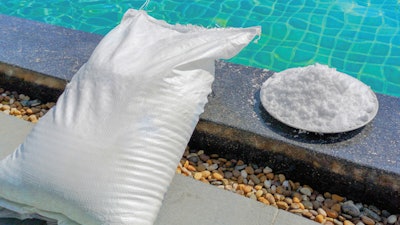
We're hearing questions about the proper time to add salt to newly plastered pools that will have saltwater chlorine generators (SWCG) installed:
Is it okay to add within the first week of a new plaster pool being filled with water? Or should the plaster cure (hydrate) for 28 days before adding salt? Does adding salt have any negative effects on the new plaster?
To answer those questions, the onBalance team conducted some experiments in a laboratory to determine what effects salt may have on the curing and hydration process of new plaster.
It was observed during the experiments that when adding salt to balanced water containing a new fresh plaster coupon, the pH of the water rose very quickly and much higher than the other normal. Even after adding acid repeatedly to lower the pH, the pH rises again quickly and generally above 8.5. This indicates that calcium hydroxide (a plaster component) is being dissolved and removed (uniformly) from a plaster surface when saltwater concentration is present.
That detrimental effect causes porosity of the plaster finish, which weakens and ages the surface. Adding salt at start-up also makes it more difficult to get the pH down and balance the pool water during the startup period.
It was also observed that the negative effect (increased calcium hydroxide dissolution and pH rise) of adding salt to new plaster pools only lasts about two to three weeks. That is because a very thin layer of the new plaster coat (immediate surface) typically becomes “carbonated” (calcium hydroxide being converted into calcium carbonate) over the first two to three weeks after filling with balanced water.
This (carbonation) conversion creates a protective thin layer and more durable plaster surface. It appears that once a plaster surface has been sufficiently and properly carbonated, salt water (less than 5000 ppm) no longer has the same negative effect.
Our experiment used well-made plaster coupons, which received proper curing, and positive LSI water.
The results obtained strongly indicate that adding 3000 ppm of salt has a detrimental effect on new plaster when added at any time during the first two to three weeks.
The bottom line: Waiting 30 days before adding any salt is recommended for plaster pools, including for quartz and pebble pools. And, of course, when adding salt to the pool, never allow undissolved salt to lie and remain on the plaster surface for any length of time.
EXAMINING THE PROCESS IN GREATER DETAIL
Let’s consider what happens in the initial days and weeks of a new plaster surface. When plaster is applied and a new pool is filled, the cement portion of the new, hardened pool plaster contains about 20% calcium hydroxide, the rest being primarily calcium silicates, aluminates and carbonates. These latter products are durable and relatively insoluble in water.
However, calcium hydroxide, which has a pH of about 12, is softer, somewhat soluble, and can be dissolved from a plaster surface even by balanced tap water. Indeed, the Saturation Index as a maintenance tool to protect calcium carbonate is not applicable to fresh new plaster (i.e., less than a few weeks old) because the new plaster has a significant amount of calcium hydroxide on the surface.
That is why the pH of the water in a freshly filled pool typically rises as the pool is being filled. The high pH calcium hydroxide dissolves from the plaster surface and enters the water, causing the pH to rise. Fortunately, after a few weeks, the new plaster surface becomes carbonated (which means calcium hydroxide has been converted to calcium carbonate) and the dissolution process and pH rise are mitigated.
The calcium hydroxide that dissolved into the pool water generally converts into calcium carbonate. That becomes what is often called “plaster dust” in new plaster pools. When undergoing a traditional start-up process, carbonation of the surface usually lasts about 1 1/2 to 2 weeks… which is why new plaster dust is generated for that long — and then stops. At that time, the pH becomes more stable because calcium hydroxide is no longer being readily dissolved into the pool water.
If in the field proper plastering practices are not followed, producing a lower quality finish and a more porous surface, more time may be needed for complete carbonation and before salt should be added.












































